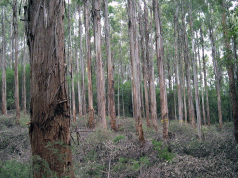| WATER S.O.S TASMANIA | |
| Monocultures ... Monsters in the
Making ©Malini Alexander |
|
 |
The fact that a monoculture plantation of E nitens could be the source of toxins found by Dr Marcus Scammell and Dr Alison Bleaney, should raise questions about the viability of these plantations in Tasmania. |
| While the debate about isolating toxins continues,
perhaps we should be addressing the larger issue – the practice
of monocultures.
The focus should be broader issues of sustainability in forestry and agriculture. Monocultures are bad and this is no new idea. For years the scientific community has known about the negatives of monocultures, yet, this outdated, unsustainable practice has somehow survived as the method of choice for agriculture and forestry in Tasmania today. The horrors of monocultures, are explored by acclaimedenvironmentalist, Vandana Shiva, in her brilliant work "Monocultures of the Mind". She is particularly scathing of this practice in forestry where it can have the most devastating impact. Apart from being inherently unsustainable due to the lack of biodiversity that a monoculture implies, the following are well known facts: Monocultures: • Alter ecosystems by changing feedback mechanisms, interactions
between species and species interdependence Each of these points in turn, can have flow-on effects
into other areas of society. Around the Globe, monocultures have
been linked to: Just as in economics where MON-opolies are regarded as bad, and the polar opposite of the healthy, ideal "perfect competition" model, where there are a diverse number of suppliers in a market, monocultures in agriculture and forestry are bad. Monocultures in social cultures are also bad. Research has linked a decline in traditional cultures and practices, to a decline in ecosystem health. Even in business, it is a recognised fact that groups composed of individuals who are too similar, exhibit a phenomenon called "group think" are less productive and less innovative. Diversity is an important necessity in many contexts. Implicitly, Monocultures are bad. Horribly, it seems, that monocultures can actually contribute to the toxicity of soil and water and that this can be true of GM or non-GM crops. Hundreds of thousands of hectares of E nitens have been planted around the world, leaving a trail of environmental and social problems wherever they take root. Ho & Cummins (2005) from the Institute of Science in Society,
report that in some countries, locals call E nitens "the
"selfish tree", because eucalyptus plantations remove
nutrients from the soil and In Tasmania, over 300 000 hectares of E nitens exist. E nitens are capable of contaminating the gene pool of other Eucalyptus species in wild forests, which raises additional concerns about biodiversity. If the toxins found from the E nitens in St Helens do turn out to be "naturally occurring" this in no way lessens the severity of the issue. Some of the most feared toxins are natural; cyanide, botulism, ergotamine and other alkaloids are examples. It would also be unacceptable to find traces of these substances in waterways, and it would indicate a need to change the practice responsible. The presence of toxins in water should trigger the Precautionary Principle and a deep investigation into other methodologies that can replace the polluting practice. There are alternatives to monocultures in forestry, but they need to be taken seriously and implemented. A proven, sustainable method of forestry is to change the focus from timber, as a means of producing profit, to Non Timber Forest Products (NTFPs). Since it's all about the bottom line, there are smarter ways of turning a profit, than relying on timber or wood chip from plantations. Permaculture NTFP can be planted with multi-species for multiproducts that ultimately fetch a higher market price compared to wood chip or timber. The benefits of permaculture NTFP plantations are the following: • They never require felling, and provide permanent tree
cover (and hence all the benefits of forests including a permanent
carbon sink) NTFP agroforestry has been practiced by many cultures around the world, before the modern advent of large-scale monoculture, pushed by globalisation. This alternative method was the secret of other cultures survival and their minimal impact on natural resources. For an example, in India NTFP agroforestry was the reason that such a huge population was able to survive on such a tiny landmass for thousands of years. Today there are many organizations around the World that have recognised permaculture NTFP as a superior methodology to monocultures. These include the International Union for the Conservation of Nature, The Global Non-Timber Forest Products Partnership, The United Nations Environment Programme and the World Conservation Monitoring Centre. We pride ourselves on being developed, clean and green in Tasmania. "Sustainable development" is the catch cry of talk in industry, politics and the media. Monocultures are the antithesis of sustainable development. If we truly want to implement sustainable development then we need to address this issue and start experimenting with other land-use practices. A short term, quick-money focus and desperation has driven industry
to choose monocultures, but it invites a vicious cycle, that will
ultimately end in a number of environmental, economic and social
crises which will be much harder to solve later, than sorting
out the issue now. |
|